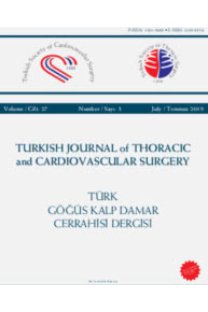Short-term clinical and hemodynamic results of the sorin soprano and sorin more bioprosthesis valves
Short-term clinical and hemodynamic results of the sorin soprano and sorin more bioprosthesis valves
___
- 1. ACC/AHA guidelines for the management of patients with valvular heart disease. A report of the American College of Cardiology/American Heart Association. Task Force on Practice Guidelines (Committee on Management of Patients with Valvular Heart Disease). J Am Coll Cardiol 1998; 32:1486-588.
- 2. Carpentier A, Dubost C, Lane E, Nashef A, Carpentier S, Relland J, et al. Continuing improvements in valvular bio prostheses. J Thorac Cardiovasc Surg 1982;83:27-42.
- 3. Pelletier LC, Carrier M, Leclerc Y, Lepage G, deGuise P, Dyrda I. Porcine versus pericardial bioprostheses: a comparison of late results in 1,593 patients. Ann Thorac Surg 1989; 47:352-61.
- 4. Banbury MK, Cosgrove DM 3rd, Lytle BW, Smedira NG, Sabik JF, Saunders CR. Long-term results of the Carpentier Edwards pericardial aortic valve: a 12-year follow-up. Ann Thorac Surg 1998;66(6 Suppl):S73-6.
- 5. Marchand MA, Aupart MR, Norton R, Goldsmith IR, Pelletier LC, Pellerin M, et al. Fifteen-year experience with the mitral Carpentier-Edwards PERIMOUNT pericardial bioprosthesis. Ann Thorac Surg 2001;71(5 Suppl):S236-9.
- 6. Folliguet TA, Le Bret E, Bachet J, Laborde F. Pericarbon pericardial bioprosthesis: an experience based on the lessons of the past. Ann Thorac Surg 2001;71(5 Suppl):S289-92.
- 7. Cen YY, Glower DD, Landolfo K, Lowe JE, Davis RD, Wolfe WG, et al. Comparison of survival after mitral valve replacement with biologic and mechanical valves in 1139 patients. J Thorac Cardiovasc Surg 2001;122:569-77.
- 8. Peterseim DS, Cen YY, Cheruvu S, Landolfo K, Bashore TM, Lowe JE, et al. Long-term outcome after biologic versus mechanical aortic valve replacement in 841 patients. J Thorac Cardiovasc Surg 1999;117:890-7.
- 9. Banbury MK, Cosgrove DM 3rd, White JA, Blackstone EH, Frater RW, Okies JE. Age and valve size effect on the long term durability of the Carpentier-Edwards aortic pericardial bioprosthesis. Ann Thorac Surg 2001;72:753-7.
- 10. Totaro P, Degno N, Zaidi A, Youhana A, Argano V. Carpentier-Edwards PERIMOUNT Magna bioprosthe- sis: a stented valve with stentless performance? J Thorac Cardiovasc Surg 2005;130:1668-74.
- 11. Firstenberg MS, Morehead AJ, Thomas JD, Smedira NG, Cosgrove DM 3rd, Marchand MA. Short-term hemodynamic performance of the mitral Carpentier-Edwards PERIMOUNT pericardial valve. Carpentier-Edwards PERIMOUNT Investigators. Ann Thorac Surg 2001;71(5 Suppl):S285-8.
- 12. Pibarot P, Dumesnil JG. Hemodynamic and clinical impact of prosthesis-patient mismatch in the aortic valve position and its prevention. J Am Coll Cardiol 2000;36:1131-41.
- 13. Badano LP, Pavoni D, Musumeci S, Frassani R, Gianfagna P, Baldassi M, et al. Stented bioprosthetic valve hemodynamics: is the supra-annular implant better than the intra-annular? J Heart Valve Dis 2006;15:238-46.
- 14. Thiene G, Laborde F, Valente M, Gallix P, Talenti E, Calabrese F, et al. Morphological survey of a new pericardial valve prosthesis (Pericarbon): long-term animal experimental model. Eur J Cardiothorac Surg 1989;3:65-74.
- 15. Eichinger WB, Botzenhardt F, Wagner I, Bleiziffer S, Ruzicka DJ, Guenzinger R, et al. Hemodynamic evaluation of the Sorin Soprano bioprosthesis in the completely supra annular aortic position. J Heart Valve Dis 2005;14:822-7.
- ISSN: 1301-5680
- Yayın Aralığı: Yılda 4 Sayı
- Başlangıç: 1991
- Yayıncı: Bayçınar Tıbbi Yayıncılık
Right atrial angiosarcoma mimicking a myxoma: from a wrong diagnosis to a difficult decision
Flavia COCCONCELLİ, Flippo BENASSİ, Matteo SCAPİNELLİ, ROBERTO PARRAVİCİNİ
Short-term clinical and hemodynamic results of the sorin soprano and sorin more bioprosthesis valves
İsmet DİNDAR, Noyan Temuçin OĞUŞ, Murat BAŞARAN, Ruken Bengi BAKAL, Eylül KAFALI, Özer SELİMOĞLU, Hamiyet ÖZCAN
Akciğer kanseri evrelemesinde mediastinoskopinin rolü
Mehmet YILDIRIM, Oya İMAMOĞLU, Murat YAŞAROĞLU, Bülent AYDEMİR, Hatice Coşğun DEMİRBAĞ, Gökhan GÜNEREN, Hakan İLTER, Ilgaz DOĞUSOY
Çocuklarda ekstrakorporeal membran oksijenatör kullanımı
Left ventricular perforation during cardiac catheterization: a case report
Şenol YAVUZ, Ahmet Hakan VURAL, Tamer TÜRK, Hakan ÖZKAN, Yusuf ATA
Thromboembolic occlusion of upper extremity arteries
Ferşat KOLBAKIR, Atilla SARAC, Muzaffer BAHÇİVAN, Onur DOYURGAN, M. Kemal DMİRAĞ, Tahsin KEÇELİGİL
Subklavyan steal sendromunun cerrahi tedavisinde subklavyan-karotis transpozisyonu
Erdal ASLIM, Hakkı Tankut AKAY
Gecikmiş yabancı cisim aspirasyonuna bağlı bronşiyal membran
Handan İNÖNÜ, Serhat ÇELİKEL, Ali YEĞİNSU, Makbule ERGİN
Pediatrik ameliyat sonrası kardiyak yoğun bakımda trakeostomi endikasyonları ve sonuçları
Batuhan ÖZAY, Yavuz ENÇ, Umut AYOGLU, Nurgül YURTSEVEN, Yeşim BİÇER, Sertaç ÇİÇEK, Alper GÖRÜR, Fırat ALTIN, Numan AYDEMİR, Gökcen ORHAN
